<< Previous | Displaying results 5951-6000 of 6769 for "" | Next >>
Norbert Yasharoff, a Bulgarian Jew, wearing the compulsory star of David. His young sister was not then required to wear a star. Pleven, Bulgaria, between May and September 1943.
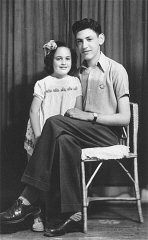
Jews from Macedonia who were rounded up and assembled in the Tobacco Monopoly transit camp before deportation to the Treblinka killing center. Skopje, Yugoslavia, March 1943. The Jews of Bulgarian-occupied Thrace and Macedonia were deported in March 1943. On March 11, 1943, over 7,000 Macedonian Jews from Skopje, Bitola, and Stip were rounded up and assembled at the Tobacco Monopoly in Skopje, whose several buildings had been hastily converted into a transit camp. The Macedonian Jews were kept there…
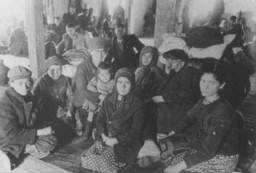
Aleksander Belev, Bulgarian commissioner for Jewish Affairs (center, wearing hat and facing the camera), oversees the deportation of Jews. Skopje, Yugoslavia, March 1943.

Jews outside the Monopol tobacco factory, used as a transit camp by Bulgarian authorities during deportations from Macedonia to the Treblinka killing center in German-occupied Poland. Skopje, Yugoslavia, March 1943. The Jews of Bulgarian-occupied Thrace and Macedonia were deported in March 1943. On March 11, 1943, over 7,000 Macedonian Jews from Skopje, Bitola, and Stip were rounded up and assembled at the Tobacco Monopoly in Skopje, whose several buildings had been hastily converted into a transit camp.…
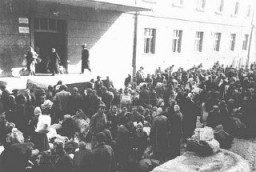
Jews prepare soup outside the Monopol tobacco factory, used as a transit camp by Bulgarian authorities during deportations of Jews from Macedonia. Skopje, Yugoslavia, March 1943. The Jews of Bulgarian-occupied Thrace and Macedonia were deported in March 1943. On March 11, 1943, over 7,000 Macedonian Jews from Skopje, Bitola, and Stip were rounded up and assembled at the Tobacco Monopoly in Skopje, whose several buildings had been hastily converted into a transit camp. The Macedonian Jews were kept there…
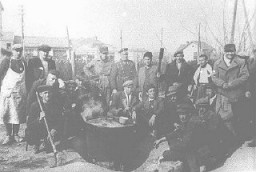
Deportation of Jews by Bulgarian authorities. Lom, Bulgaria, March 1943.
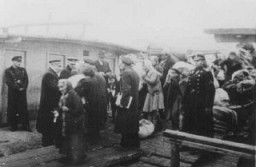
Jews forced to board a deportation ship in the Danube River port of Lom during deportations from Bulgarian-occupied territories. They were deported, through Vienna, to the Treblinka camp in German-occupied Poland. Lom, Bulgaria, March 1943.

Thracian Jews crowd the upper deck of the Karađorđe, a ship used for deportation, as it leaves the port of Lom. They were transported by ship along the Danube River to Vienna and then by rail to the Treblinka killing center in occupied Poland. Lom, Bulgaria, March 1943.
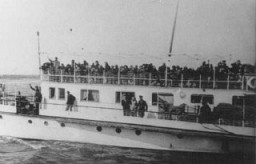
Thracian Jews crowded into an interior room of the Karađorđe, used as a deportation ship, just before it left the Danube River port of Lom. From Lom they were loaded onto four Bulgarian ships and taken to Vienna, where they were put on trains bound for the Treblinka killing center in occupied Poland. Lom, Bulgaria, March 1943.
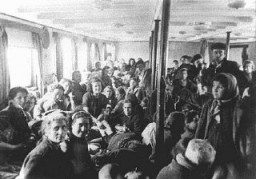
Jews from Bulgarian-occupied territories during deportation along the Danube to Vienna, from where they were deported by train to the Treblinka killing center in German-occupied Poland. Lom, Bulgaria, March 1943.
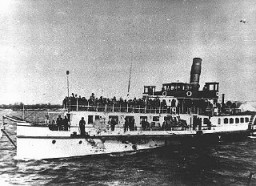
Adolf Hitler and his entourage view a military parade following the annexation of Austria (the Anschluss). Vienna, Austria, March 1938.
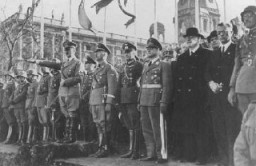
Jews wait in line at the Margarethen police station for exit visas after Germany's annexation of Austria (the Anschluss). Vienna, Austria, March 1938.
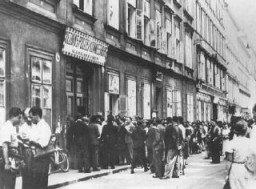
Two Jewish men (center, and at right in overcoat), carrying paint and brushes, who were forced by Austrian Nazis to paint "Jude" on the fronts of Jewish-owned businesses. Vienna, Austria, 1938.
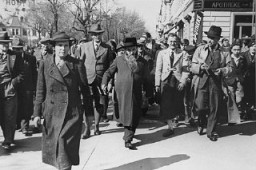
Onlookers watch as a Jewish man is forced to paint anti-Jewish graffiti on a shuttered storefront. Vienna, Austria, March 1938.
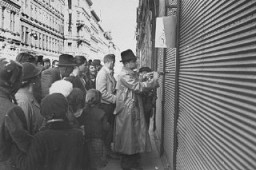
A Jewish refugee girl from Vienna, Austria, upon arrival in Harwich after her arrival in England on a Kindertransport. United Kingdom, December 12, 1938.
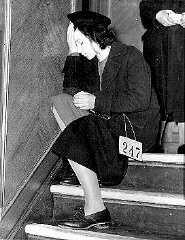
Nazis block Jews from entering the University of Vienna. Austria, 1938.
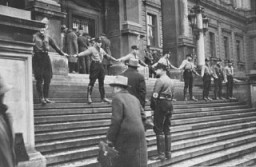
An SS officer stands in front of Jews assembled for deportation. Vienna, Austria, 1941-1942.
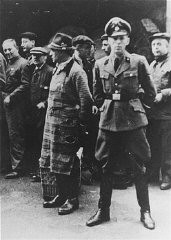
Belongings of Jews who were deported from Vienna. Austria, 1941–42.
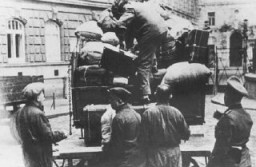
A view of Rosiers Street in the Jewish quarter of Paris. This photograph was taken before World War II. Paris, France, date uncertain.
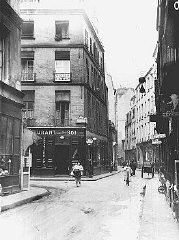
After the first roundup in Paris, French police escort foreign Jewish men from the Japy school to deportation trains at the Austerlitz station. Paris, France, May 14, 1941.
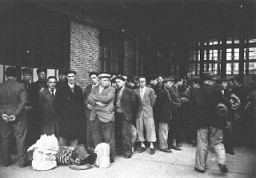
A group of Jewish men on a train platform with French policemen at the Austerlitz station before deportation to the Pithiviers internment camp. Paris, France, May 1941.
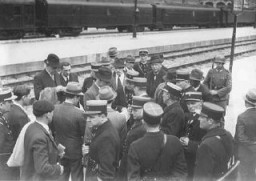
Jewish deportees, guarded by French police, board a train at the Austerlitz station for transport to the Pithiviers internment camp. Paris, France, May 1941.
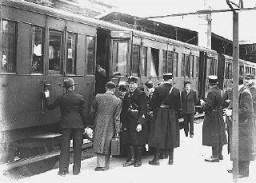
A Jewish woman carries her radio into a police station after a German order (August 8, 1941) demanded the confiscation of all radios owned by Jews. Paris, France, 1941.
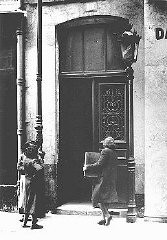
French police check the identity cards of pedestrians during the roundup of Jews on the Boulevard Voltaire (near the Place de la Republique) in Paris, France, August 20, 1941.
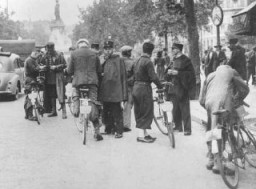
A young man in the Jewish quarter of Paris wears the mandatory Jewish badge. Paris, France, after June 1942.
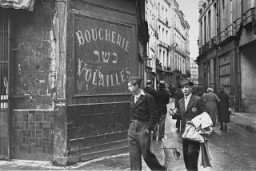
Jewish men wearing the mandatory Jewish badge in the Jewish quarter of Paris. France, after June 1942.
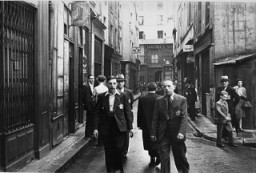
Men of the 2nd French Armored Division attack the Chamber of Deputies, one of the last German stongholds, during the battle to liberate the French capital. Paris, France, August 1944.
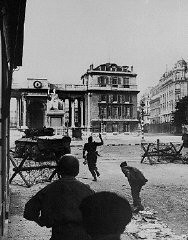
US troops march down the Champs Elysees in Paris following the Allied liberation of the city. Paris, France, August 29, 1944.
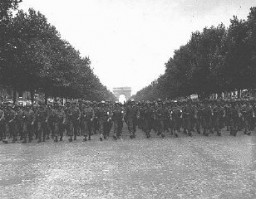
SS Lieutenant Colonel Arthur Roedl, commandant of the Gross-Rosen concentration camp. Gross-Rosen, Germany, between May 1, 1941, and September 15, 1942.
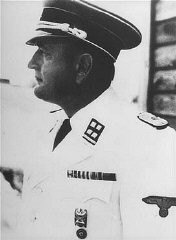
The commandant of Gross-Rosen, SS-Obersturmbannfuehrer Arthur Roedl, at his desk with a photograph of Adolf Hitler hanging on the wall. Gross-Rosen, Germany, 1941.
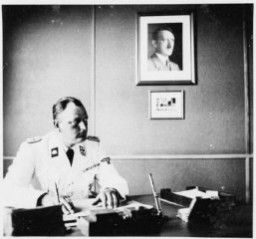
Commandant Arthur Roedl (center) and SS officers visit the Gross-Rosen concentration camp's quarry. Gross-Rosen, Germany, 1941.
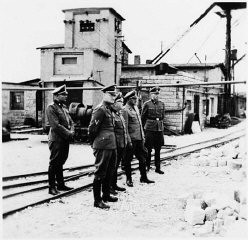
View of the Biesinitzer Grund (Goerlitz) concentration camp, a subcamp of Gross-Rosen, after liberation. Poland, May 1945.
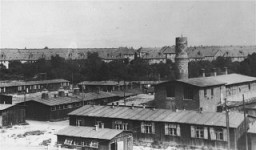
International Tracing Service (ITS) boxes containing documentation about Gross-Rosen. The archive was established by the Allied powers after World War II to help reunite families separated during the war and to trace missing family members. Bad Arolsen, Germany. Learn more about the ITS.
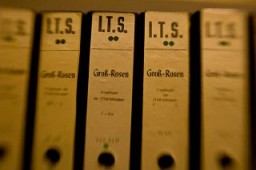
Italian Fascist leader Benito Mussolini (center) with aides and supporters. They are wearing the attire which gave them the name of blackshirts. Italy, 1920s.
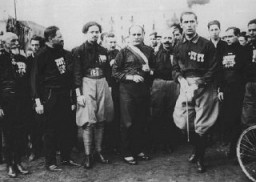
Thousands gather at the Roman Forum to listen to a speech by Italian Fascist leader Benito Mussolini. Rome, Italy, April 12, 1934.
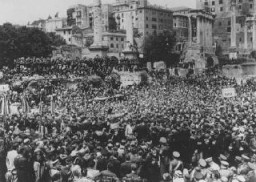
Benito Mussolini and Adolf Hitler stand together on an reviewing stand during a official visit to occupied Yugoslavia, 1941–43.
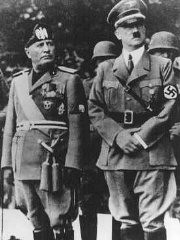
Soldiers and vehicles of the Jewish Brigade Group, which participated in the final Allied offensive in Italy. Italy, March 24, 1945.
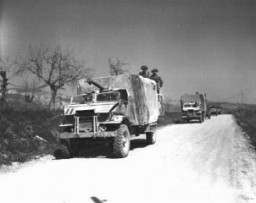
A Jewish Brigade soldier with two members of "Kibbutz Buchenwald." "Kibbutz Buchenwald" was a group of survivors from the Buchenwald concentration camp who were preparing for agricultural work in Palestine. Antwerp, Belgium, 1946.
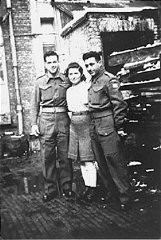
Pre-emigration training: young Jews in a cooking class in the Theodor Herzl School sponsored by the Jewish community. Berlin, Germany, between 1930 and 1939.
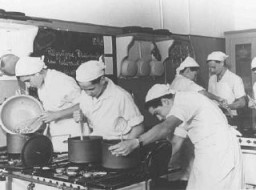
Training for emigration to Palestine: a math class at the Caputh Agricultural School. Berlin, Germany, 1930–39.
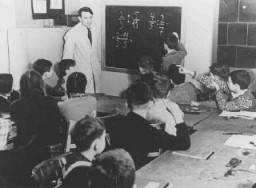
Girls in a sewing class at the Adas Israel school, maintained by the German Jewish community. Berlin, Germany, 1930s.
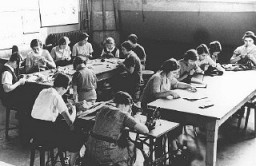
Jewish athletes at a sports festival in Grunewald stadium, Berlin. After Adolf Hitler took power, Jews were not allowed to be members of German athletic clubs. Berlin, Germany, 1934.
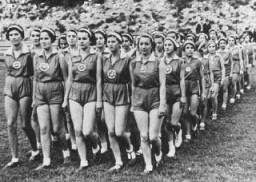
The Reich Union of Jewish Frontline Soldiers organized summer camps and sports activities for Jewish children. Germany, between 1934 and 1936.
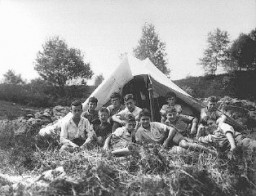
A concert in the Oranienburger Street synagogue organized by the Cultural Society of German Jews. Berlin, Germany, 1938.
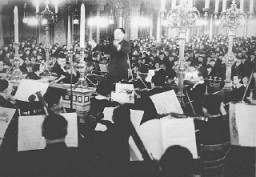
SS Second Lieutenant Gustav Willhaus, camp commandant, rides past the main gate of the Janowska concentration camp. The road from the street and into the camp was paved with tombstones the Nazis removed from Jewish cemeteries. Janowska, Poland, between September 1942 and November 1943.
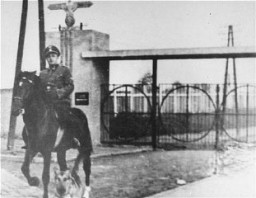
Two SS officers and a guard dog in the Janowska concentration camp. Janowska, Poland, January 1942–November 1943.
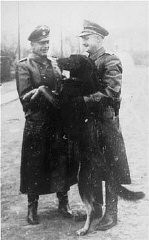
Bone-crushing machine used by Sonderkommando 1005 to grind the bones of victims after their bodies were burned in the Janowska camp. August 1944.
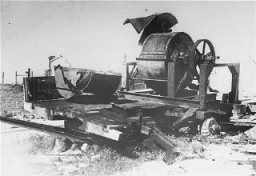
After the Anschluss (German annexation of Austria), Austrian Jewish refugees disembark from the Italian steamship Conte Verde. Shanghai, China, December 14, 1938.
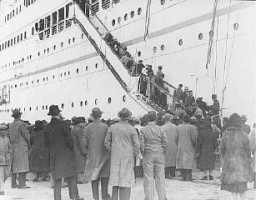
Jewish refugees from Germany and Austria arrive at the port of Shanghai. China, 1938–1939.
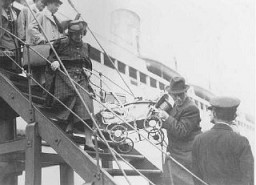
Jewish refugees at prayer in a synagogue. Shanghai, China, date uncertain.
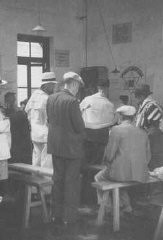
We would like to thank Crown Family Philanthropies, Abe and Ida Cooper Foundation, the Claims Conference, EVZ, and BMF for supporting the ongoing work to create content and resources for the Holocaust Encyclopedia. View the list of donor acknowledgement.